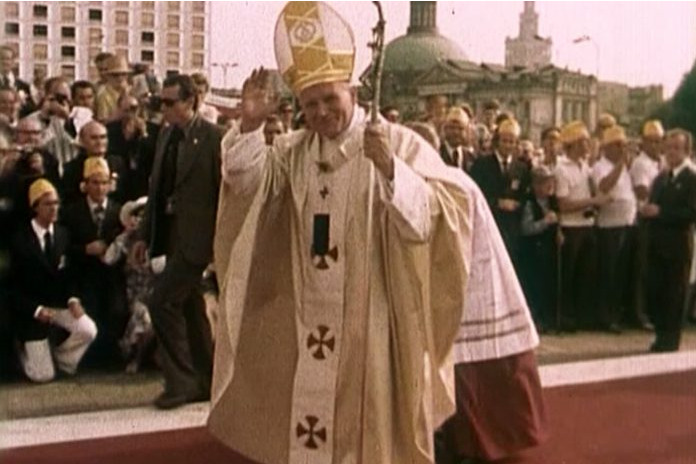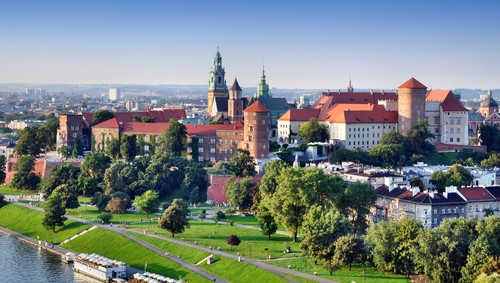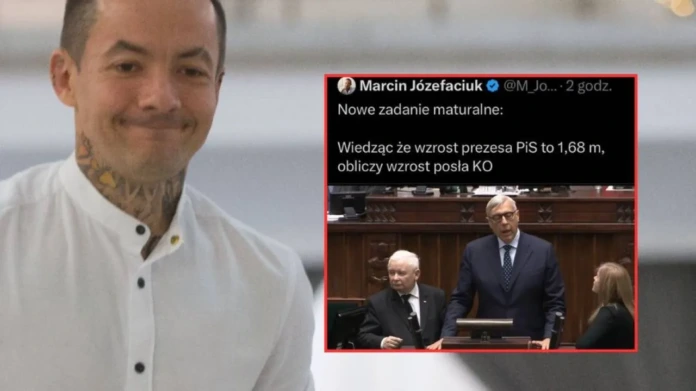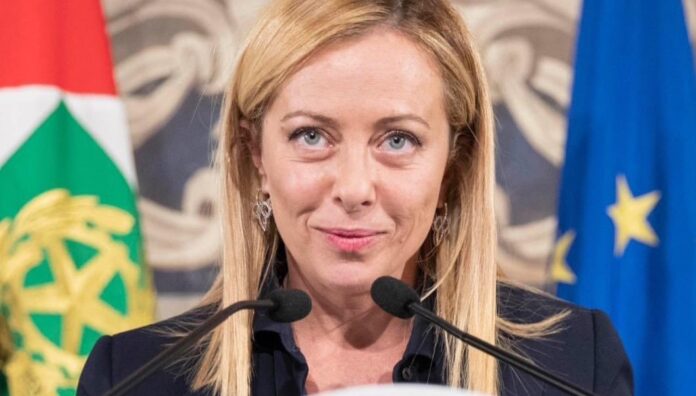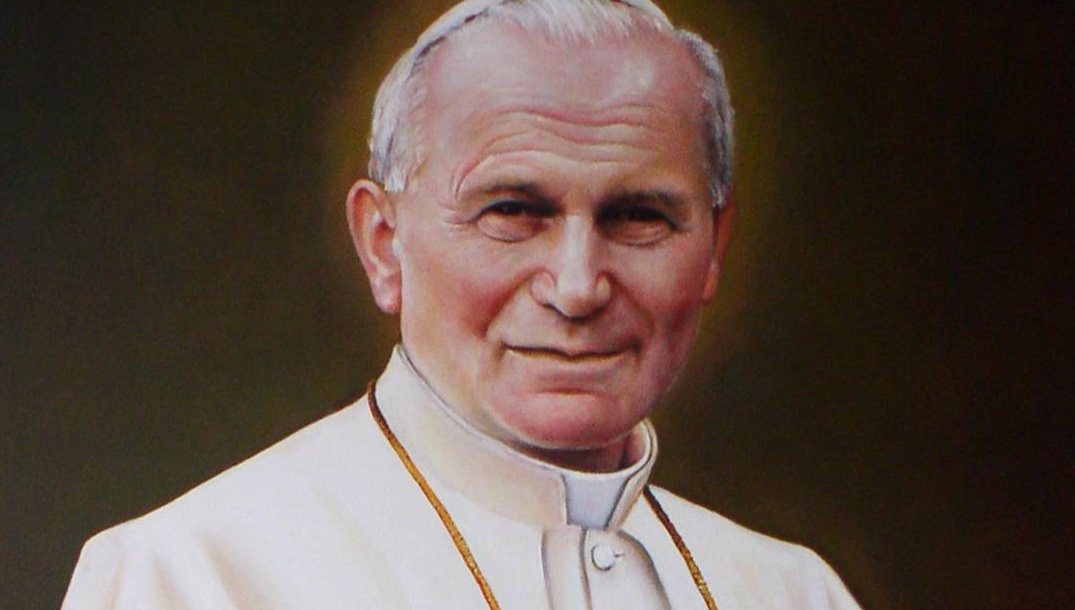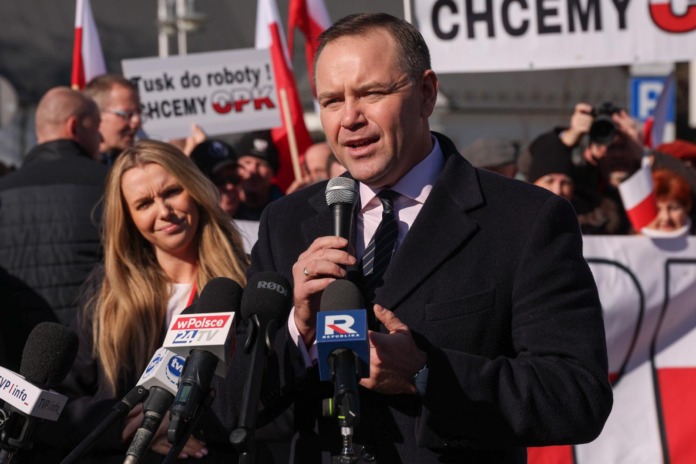When the World Held Its Breath: Marking 20 Years Since the Passing of Pope John Paul II
Crowds in the streets, overnight vigils in churches, hundreds of candles lit in places associated with John Paul II, closed stores, clubs, and offices, and joint prayers among fans of rival sports teams. The days leading up to the Polish pope’s death and those immediately following were described as “national retreats.” Twenty years ago—on April 2, 2005, at 9:37 p.m., on the eve of Divine Mercy Sunday—John Paul II died in the Vatican.
The pope was admitted to the Gemelli Polyclinic on February 1, 2005, after experiencing respiratory failure caused by laryngitis and tracheitis. Although he briefly returned to the Vatican, he was no longer able to preside over Easter celebrations. The pope’s health deteriorated rapidly again on March 31.
A national reflection
In Poland, the pope’s final days were accompanied by enormous emotion. For many days, the faithful spontaneously gathered in churches and at places John Paul II had visited during his pilgrimages.
In the Sanctuary of Our Lady of Fatima in Krzeptówki, Zakopane—which was built as a votive offering of thanks for saving the pope’s life after the 1981 assassination attempt—Highlanders (Górale) and tourists prayed all night from March 31 to April 1. Crowds of the faithful also gathered in the Sanctuary of Divine Mercy in Łagiewniki and in St. Mary’s Basilica, under the window of the Archbishop’s Palace in Krakow (where John Paul II used to appear during his visits to his homeland), and in the Basilica of the Offering of the Blessed Virgin Mary in Wadowice—the pope’s hometown.
On April 1, a large canvas composition featuring Karol Wojtyła at various stages of his life was hung on the Wadowice Town Hall building.
Starting on March 31, a round-the-clock prayer vigil took place at the Jasna Góra Sanctuary. Its gates were open to the faithful all day and night. In Warsaw, thousands of people prayed for John Paul II at the academic church of St. Anne. Nighttime vigils were also held in churches in Katowice, Piekary Śląskie, Kalwaria Zebrzydowska, Gdańsk, Łódź, Lublin, and other cities across Poland.
Members of other faiths also prayed for John Paul II. In Łódź, representatives of the Jewish community joined prayers for the pope’s health at the basilica. Iwona Alkhalayla, the chairperson of the Muslim League in Poland, confirmed that Polish Muslims also prayed for the pope’s health in their mosques.
The news no one wanted to hear
On April 1, when the world’s media mistakenly reported the death of the head of the Church, the match between Lech Poznań and Pogoń Szczecin in Poznań was stopped. Players from both teams formed a circle, put their arms around each other, and prayed together. Many fans began clapping and spontaneously chanting, “Thank you.” Then everyone sang the Polish national anthem.
Every media outlet in the country reported the pope’s condition hour by hour. Because of John Paul II’s declining health, numerous cultural, entertainment, sports, and political events were canceled. The Mayor of Warsaw, Lech Kaczyński, ordered the cancellation of performances and entertainment events in city-run theaters and cultural institutions. Krakow Mayor Jacek Majchrowski made a similar appeal. Events were canceled in Poznań, Wrocław, Bydgoszcz, Toruń, Szczecin, Rzeszów, Gdańsk, Lublin, and Częstochowa.
Upon the news of John Paul II’s death at 9:37 p.m. on April 2, thousands of people across Poland went out into the streets. The faithful spontaneously gathered in churches for joint prayers, Masses, and vigils. In places associated with John Paul II—such as the “pope’s window” on Franciszkańska Street in Krakow or St. Anne’s Academic Church in Warsaw, and in front of monuments dedicated to John Paul II—people lit candles, placed flowers, and football fans hung their scarves.
Many people placed lit candles in their windows, and church bells rang out. Over Krakow, the Sigismund Bell (Dzwon Zygmunta) resounded, rung by bell-ringers from the Wawel Cathedral. Throughout the country, papal, national, and municipal flags were displayed draped in black crepe.
Flags—the national one as well as those of NATO and the EU—were lowered in front of the Presidential Palace in Warsaw. The national government declared a period of national mourning until the pope’s funeral.
Hundreds of Masses
Starting early on April 3, numerous pilgrims arrived at Jasna Góra to pray for John Paul II. In the sanctuary and on the fields in front of the monastery, thousands of the faithful formed a “From life to life” chain at noon. Holding hands, they commended the Holy Father to Mary.
Hundreds of Masses were celebrated for the late John Paul II. On April 3, approximately 150,000 faithful attended Mass on Piłsudski Square in Warsaw. Another Mass, celebrated in the same place on April 5 with the participation of the highest state authorities, drew as many as 250,000 people. Many of the faithful carried banners that read, “You were looking for us, and we came to you—thank you for that,” “Totus Tuus,” and “Forever in our memory, Our Father.”
A Mass in Łagiewniki for the deceased pope was attended by 100,000 faithful, and about 70,000 people prayed at Jasna Góra.
On internet forums devoted to Krakow’s rival football clubs—Cracovia, Wisła, and Hutnik—hundreds of appeals appeared to end the “holy war” among the fans. On April 4, a so-called “Mass of reconciliation” was held at the Cracovia stadium, attended by about 25,000 fans of Cracovia, Hutnik, and Wisła. At the end of the Mass, the entire stadium began chanting, “Reconciliation for the pope.”
In many Polish cities, “white marches” were held to commemorate John Paul II. The first took place in Łódź on April 4, with more than 100,000 participants. The largest march took place in Krakow and gathered over a million people.
Meanwhile, in Poznań, Warsaw, Krakow, Katowice, and Łódź, Marches for the Pope were held, drawing thousands of school and university students. Asked who organized them, participants said they had learned about the initiative via the Gadu-Gadu messenger or by SMS. In Krakow, more than 150,000 people took part in the march; in Poznań, about 25,000; in Łódź, tens of thousands. In Katowice, several thousand young people met in the central square and marched with candles in their hands through the city’s streets to the cathedral.
“In the mountains, one feels closer to God”
Karol Wojtyła hiked many times in the Żywiec Beskids, the Mały (Small) and Sądecki Beskids, the Gorce Mountains, the Pieniny, the Lower Beskids, the Bieszczady, and the Sudetes. The Tatra Mountains were closest to his heart. Therefore, after the pope’s death, students from the Zakopane School of Artistic Weaving organized a pilgrimage to the Chochołowska Valley in the Tatras, one of Karol Wojtyła’s favorite places. One day earlier, a group of scouts from Rzeszów climbed Tarnica, the highest peak in the Bieszczady Mountains, where they placed a papal flag.
The final farewell
Buses with pilgrims departed from various Polish cities for the funeral of John Paul II, which took place in the Vatican on April 8. In the main hall of Warsaw’s Central Station, there was a gigantic line of people wanting to buy tickets for special trains to Rome.
For most Poles, the day of the funeral was a day off work. The streets were almost deserted, and traffic on national and urban roads decreased significantly.
The faithful could watch the funeral ceremonies on large screens set up in main squares, near city offices, and in market squares. During that time, stores, shopping centers, as well as state and provincial offices, courts, and prosecutor’s offices were closed.
Thousands of people watched the funeral broadcast on large screens set up in Piłsudski Square and Castle Square in Warsaw, at the Błonia meadows in Krakow, in the Main Square in Wadowice, near the “pope’s window” at the Krakow Metropolitan Curia, and at the foot of the monastery on Jasna Góra. After the broadcast ended, the faithful participated in Masses celebrated by local bishops.
In the evening, at the hour of the pope’s death—9:37 p.m.—lights were turned off for five minutes in many homes across the country. Church bells, sirens, and horns sounded. At the same time, candles burned in places especially connected to the pope.
On the day of John Paul II’s funeral, all nationwide television stations and the four programs of Polish Radio broadcast the funeral ceremonies in full. Music stations—such as MTV Polska and VIVA Polska—played only calm music from the beginning of the mourning period until the day of the funeral.
The profound emotion triggered by the death of John Paul II lasted many days, even weeks. Many social commentators described it as “national retreats” or “the pope’s final encyclical.”
Philip Morris Unveils Groundbreaking, Billion-Zloty Investment in Krakow—Over 300 New Jobs Created
Philip Morris Polska Distribution Sp. z o.o., a subsidiary of the global tobacco giant Philip Morris International Inc. (PMI), has announced the completion of an investment worth nearly PLN 1 billion to modernize its factory in Krakow. According to the company, the project in Krakow enabled the creation of more than 300 new jobs.
Thanks to this investment, PMI’s facility in Krakow’s Czyżyny district now manufactures tobacco inserts, among others, for the latest IQOS ILUMA i tobacco heating system, which has just gone on sale in Poland. Significantly, Polish-grown tobacco is used to produce these inserts. Over the last decade, Philip Morris has purchased more than 40,000 tons of tobacco directly from Polish farmers.
IQOS ILUMA i is the newest generation of PMI’s flagship tobacco heating system, powered by its SMARTCORE INDUCTION SYSTEM technology. The device heats the tobacco insert via induction, rather than with a heating blade. During use, the tobacco doesn’t burn, and no smoke is produced. The IQOS ILUMA i device is equipped with a touchscreen and innovative features such as a pause function (allowing the user to interrupt and resume the heating session) and FlexPuff (which adjusts the session’s length to the consumer’s individual usage patterns).
A Smoke-Free Future Is Closer
The modernization of PMI’s Krakow factory included, among other things, new production lines for heated tobacco inserts. The inserts produced in Krakow have already reached the Polish market and are also being exported to international markets—including EU countries and Asia, with Japan being one notable destination. Japan was the site of the global premiere of the IQOS devices in 2014.
– “We are phasing out cigarettes worldwide faster than any other tobacco company. Since IQOS was introduced, we have reduced the volume of cigarettes we put on the global market by as much as 28 percent. Now, our Krakow factory is joining the ranks of facilities at the forefront of our global transformation. We’re moving from being a cigarette manufacturer to becoming a company that creates smoke-free products,” says Michał Mierzejewski, President of PMI for Northeast Europe. “We are one of the largest American investors in Poland. We have invested more than PLN 27 billion here in total. We’re the largest taxpayer and employer in our industry, providing jobs for over 7,000 people in the country,” he adds.
Philip Morris—one of the biggest international corporations operating in Poland—paid PLN 1.44 billion in taxes to the Polish government in 2023.
Over $14 Billion Invested in Research on Alternatives to Cigarettes
PMI notes that developing the heated tobacco inserts for IQOS was made possible through collaboration with Polish engineers at International Tobacco Machinery (ITM) in Radom, who designed modern machines for producing this new type of product. Globally, PMI has invested more than $14 billion in scientific research, technology development, and the commercialization of smoke-free products, which represent a less harmful alternative compared to continued cigarette smoking. To achieve this, the company employs around 1,500 scientists, engineers, and specialists in various fields. PMI’s smoke-free products are currently available on 95 markets worldwide.
According to international estimates, more than one billion people around the world still smoke cigarettes. In Poland, over 8 million people remain smokers.
Cruel Height Jab Crosses All Boundaries: KO MP Apologizes Under Mounting Pressure
At the start of today’s session of the Sejm, a heated argument broke out, culminating in a moment when Roman Giertych (Civic Coalition, KO) and Jarosław Kaczyński (chairman of Law and Justice, PiS) both appeared at the lectern. Photos of the two politicians together quickly went viral. A KO MP—Józefaciuk—used these images to post a mocking remark online.
“New high school graduation problem: Knowing that the PiS chairman’s height is 1.68 m, calculate the KO MP’s height,” wrote Józefaciuk. The backlash against him was immediate.
“We’re making fun of both men’s heights. What a riot, right? (But at whose expense? Ha, ha, ha…). Let me remind you that Mr. Józefaciuk was/is a teacher… Sir, you’ve shown yourself to be a very small man,” wrote Olsztyn councilor Marcin Możdżonek, a former member of Poland’s national volleyball team (who stands at 211 cm tall).
“A teacher and an MP mocking someone’s height. One might be short, but you are simply small,” added Jakub Wiech, questioning whether Józefaciuk had similarly mocked his own students as a teacher.
Facing a wave of criticism, MP Józefaciuk finally backed down.
“Indeed, my last post was neither in good taste nor did it contribute anything substantive. Emotions are never good advisers. I apologize,” he wrote, later admitting that his words were “rude and hateful.” The KO MP has since deleted the controversial post from X (formerly Twitter).
Meloni: St. John Paul II Changed History
Italian Prime Minister Giorgia Meloni wrote on Wednesday, the 20th anniversary of John Paul II’s death, that he shaped the 20th century and changed history. She emphasized that he remains in the memory of billions of people.
The head of the Italian government wrote on platform X:
“Twenty years ago, on April 2, 2005, Saint John Paul II departed from Earth to heaven. His spiritual strength, his love for freedom, and his ability to bring faith closer to men and women of all generations and from every corner of the world remain alive in the memory and hearts of billions.”
“I am honored to have met and known such an extraordinary figure, who, through his life, actions, and example, shaped the 20th century and changed history. Thank you for everything, Saint John Paul II,” Meloni added.
Vent’anni fa, il 2 aprile 2005, San Giovanni Paolo II passava dalla terra al cielo.
— Giorgia Meloni (@GiorgiaMeloni) April 2, 2025
La sua forza spirituale, il suo amore per la libertà e la sua capacità di avvicinare alla fede uomini e donne di ogni generazione e latitudine restano vivi nella memoria e nel cuore di miliardi… pic.twitter.com/WzamzpeTwS
The Prime Minister will attend a Mass at St. Peter’s Basilica, which will be celebrated by Vatican Secretary of State Cardinal Pietro Parolin on the anniversary of the Polish pope’s death.
All of Poland Remembers St. John Paul II. A Rich Program for the 20th Anniversary of the Polish Pope’s Death
Today marks 20 years since the death of the Polish pope, St. John Paul II. To honor the occasion, numerous cities are hosting commemorative events, including Masses, prayer vigils, concerts, film screenings, and conferences. In the pope’s hometown of Wadowice, a Mass and prayer vigil will be held, among other tributes.
Twenty years ago—on April 2, 2005, at 9:37 PM, on the eve of Divine Mercy Sunday—Cardinal Karol Wojtyła, Pope John Paul II, passed away in the Vatican at the age of 84. His pontificate lasted 26 years. He was beatified by Pope Benedict XVI on May 1, 2011, and canonized by Pope Francis on April 27, 2014.
“Where Are We 20 Years Later?”
“This year’s anniversary is a good moment for self-examination and to honestly ask: Is John Paul II just a photo and a cream puff (kremówka), or something more? What remains of the great vision of his generation? Where are we now after these 20 years?” said Archbishop Adrian Galbas, Metropolitan of Warsaw.
He emphasized that “we should return to the pope’s teachings—even those that may sometimes be difficult or even painful for us.”
“John Paul II was not a ‘flatterer’ but always a demanding, sometimes even strict, teacher and mentor,” he added.
The archbishop noted that “Wojtyła’s language—his sharp metaphors, profound imagery, and clear sentences—can still resonate with young people today, but they are too rarely revisited.”
Meanwhile, Archbishop Tadeusz Wojda, head of the Polish Bishops’ Conference (KEP), stated that John Paul II’s pontificate “left traces of holiness, goodness, truth, honesty, and everything humanity deeply needs to fulfill its human and Christian calling.”
Warsaw
In the capital, central commemorations include a Mass at St. John the Baptist Archcathedral, followed by a concert of the oratorio 14 Encyclicals at 7 PM, performed by the Warsaw Choir and Orchestra of St. John Paul II under Zofia Borkowska’s direction. The piece draws from diverse musical traditions—Gregorian chant, Orthodox hymns, jazz, and pop—reflecting the universality of the Polish pope’s theological message.
The anniversary also launches the year-long series “Duc in Altum – Put Out into the Deep,” featuring lectures and concerts exploring John Paul II’s spiritual legacy.
At St. Michael the Archangel and St. Florian Cathedral, the John Paul II Center Choir will perform “Astonished by the Light,” preceded by a Mass led by Bishop Romuald Kamiński. An exhibition, “Karol Wojtyła – Inspirations,” will also be displayed.
The John Paul II Center has initiated the social campaign “See the Person,” addressing judgment and stereotypes, reminding society of each individual’s inherent dignity.
Kraków
In the Archdiocese of Kraków, the main ceremonies, led by Archbishop Marek Jędraszewski, will take place at the St. John Paul II Sanctuary. After a 5 PM Mass, a conference titled “Hope Does Not Disappoint” will be held, followed by an Academic Way of the Cross at 8:30 PM.
Wadowice
In the pope’s birthplace, Bishop Sławomir Oder—postulator for John Paul II’s sainthood—will celebrate a noon Mass at the Basilica of the Presentation of the Blessed Virgin Mary. An evening vigil will include a procession to his family home, where the Divine Mercy Chaplet will be prayed at 9:37 PM.
Two exhibitions are on display: an outdoor photo exhibit “I Sought You, and Now You Have Come to Me” (AFP) and Grzegorz Gałązka’s intimate photographs of the pope’s final months. At 9:37 PM, the film “21.37” (dir. Mariusz Pilis) will screen, capturing Poland’s profound mourning in 2005.
Poland and Abroad
In Białystok, the University Chamber Choir will premiere Requiem Trotta after a Mass led by Archbishop Józef Guzdek. Szczecin will host a prayer vigil at John Paul II’s Jasne Błonia Square, while Gdańsk’s Oliwa Archcathedral will feature Mozart’s Requiem interspersed with the pope’s writings.
In Rome, Archbishop Wojda will lead a vigil at St. Peter’s Square, with multilingual Scripture readings and a choir performance.
Nawrocki: We Live in a Poland Where Volunteer Firefighters Are Pressured by the State
Today, we live in abnormal times—let’s call it what it is. We live in a reality where Polish state institutions are being used in an election campaign—we’re talking about the prosecutor’s office, the Supreme Audit Office (NIK), and unfortunately, even the Prison Service. We live in a Poland where volunteer fire departments (OSP) are being pressured by the Polish state. Firefighters are interrogated by the Internal Security Agency (ABW) and prosecutors simply because they accepted support from the Polish government—fire trucks or other equipment that we all need, said Dr. Karol Nawrocki today in Alwernia (Lesser Poland Voivodeship).
During a press conference in Alwernia, Dr. Karol Nawrocki, a candidate for president of Poland, emphasized that OSP units are “not just a cultural heritage but also the real, daily hard work of firefighters.”
“As president, I will take OSP activities under my patronage and advocate for them to benefit from what was normal during the eight years of the United Right’s governance—support from the Polish government through various development projects. Today, we live in abnormal times, and we must call it by its name. We live in a reality where state institutions are being weaponized in an election campaign—the prosecutor’s office, NIK, and even the Prison Service. We live in a Poland where OSP units face pressure from the state. Firefighters are being interrogated by the ABW and prosecutors just because they accepted fire trucks or other essential equipment from the government. This must end. A state whose institutions harass volunteer firefighters must come to an end,” Nawrocki declared.
The candidate stressed that “firefighters need state support, not a state that persecutes them when they try to save lives.”
“Civil security is a challenge for everyone. Poland will be safe when we achieve military, energy, and food security—but also when we ensure civil security, which cannot be built without firefighters, both professional (PSP) and volunteer (OSP). Poland’s rescue system is one of the best, and many countries envy what we’ve built thanks to the dedication of our firefighters and volunteers,” he added.
Karol Nawrocki – Konferencja prasowa Kandydata na Prezydenta RP | Alwernia #Nawrocki2025 https://t.co/AcVk4XaPSs
— #Nawrocki2025 (@Nawrocki25) April 2, 2025

